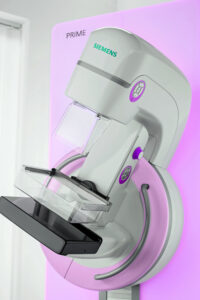 Breast Exams and Breast Health
Breast Exams and Breast Health
With the latest wide-angle 3D imaging capabilities at Glacial Ridge Hospital, breast cancer has nowhere to hide. The newest mammography system from Siemens was designed with you in mind, and it provides unparalleled early detection. That means higher diagnostic accuracy in the detection of early breast cancer versus standard 2D technology and clearer imaging resulting in fewer callbacks for a second look.
Benefits of Breast Exams with 3D Mammography
- A more inviting exam, increased comfort, and less compression
- The lowest radiation dose possible – with uncompromised image quality
- Tailored exams with individual dosing needs
- Wide-angle at 50 degrees
For your next screening or diagnostic mammogram, with optimal comfort and image clarity, choose 3D Mammography at Glacial Ridge Health System. Schedule your next annual well-woman exam and mammogram the same day for your convenience.
Screening Guidelines for Breast Health
Who should have a mammogram? The American Congress of Obstetricians and Gynecologists, American College of Radiology, and Society of Breast Imaging recommend that women at average risk start getting annual mammograms at age 40. The American Cancer Society recommends that most women should begin at age 45. Since there are many risk factors, women are encouraged to have discussions with their doctor to make a shared decision regarding what age to begin screenings and how frequently to have them as they age.
For women at risk for breast cancer, our breast health experts encourage following these breast cancer screening recommendations:
- Breast self-awareness
- Clinical breast exam
- Mammography
- Advanced diagnosis
Breast Imaging
A routine breast health evaluation should include imaging. Breast imaging is an important part of diagnosing breast cancer. Here are the three major types of imaging:
- Mammography – 2D and 3D
- Ultrasonography
- Breast MRI
- Performing an MRI can determine the extent, size, and distribution of recently diagnosed breast cancer. A Breast MRI can also be used to screen women at high risk of developing breast cancer or for women who had a mammogram that was unclear. (Not all hospitals have Breast MRI capabilities. When needed, GRHS patients are referred to a hospital that does Breast MRIs.)
Breast Biopsy
Following imaging, suspected breast disease can be confirmed by performing a tissue biopsy. Our surgeons expertly perform breast-conserving surgery for patients at GRHS. Their goal is to catch the disease in its early stages to increase the chances of survival.
A sentinel lymph node biopsy is a surgery that takes out lymph node tissue to look for cancer. A sentinel node biopsy is used to see if known cancer has spread from the original cancer site. A sentinel node biopsy may be done instead of a more extensive surgery called lymph node dissection.
Early Detection is Vitally Important
Studies have shown that, when detected early, the chance for successful treatment of breast cancer is nearly 100%. Methods for early detection of breast cancer include clinical breast examinations, self-examinations, and screening mammograms. A screening mammogram can identify an abnormal breast mass as early as two years before it can be detected by clinical or self-examinations.
Breast Density and Screening
In 2013, the American College of Radiology and Society of Breast Imaging provided new information for women with dense breasts regarding breast cancer screening. Why is breast density important and how do you know if you have dense breast tissue? Please talk to your doctor. Together, you can decide which, if any, additional screening exams are right for you. For more information about breast density and specific screening, read our brochure on Breast Density.
To schedule a screening, call 320.634.2273.

